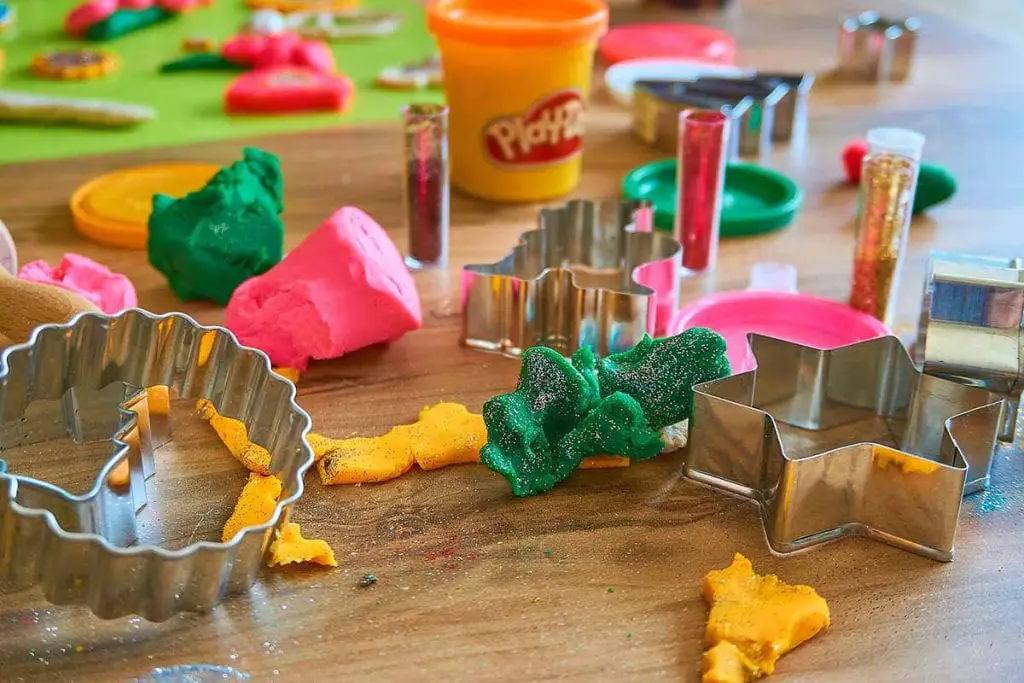Play dough is a hit with the kids because it’s a fun, pliable substance that children can use to make various shapes. Today, I’ll be giving you a comparison of Softee Dough vs Play-Doh which is two of the most popular brands on the market.
In this article, I’ll introduce you to these amazing products and compare the differences and similarities between the two. Your kid (like my daughter) will probably love twisting, rolling, and creating works of art with these two products.
Not only is play dough fun, but it also teaches them hand-eye coordination, exercises their tiny hand muscles, and helps improve the dexterity that they will need for writing one day. Which one should you pick?
Softee Dough vs Play-Doh – Similarities and Differences
Softee Dough was developed as an alternative to Play-Doh and is supposed to be a lot less messy than its counterpart. However, Play-Doh has a softer texture and has a pleasant fragrance. Let’s take a look at the differences and similarities between the two products in this next section.
What does Softee Dough and Play-Doh Smell Like?
If you have ever taken a big whiff of Play-Doh then I’m sure you’ll agree that the salty smell reminds you of lazy days spent on the beach. Additionally, Play-Doh has a sweet vanilla scent to it that smells like cookies.
On the other hand, Softee dough has a strong petroleum smell that might be a bit overpowering at first. The good news is, the more you play with it, the more the odor decreases.
Texture of Softee Dough and Play-Doh
These products are made up entirely of different compositions. Play-Doh is soft and crumbly and can be made from ingredients that you normally find in your kitchen. Softee Dough has a rubbery feel and seems to be petroleum-based and leaves an oily residue on your hands when playing with it.
The Pliability of Softee Dough and Play-Doh
Play-Doh is easy to shape and holds its shape well. It can be twisted, used to create impressions, stretched, and you can break it into pieces easily. The only downside is it breaks quite easily and leaves pieces behind, especially under your fingernails and on the molds.
Softee Dough is similar to plasticine and doesn’t bend as well as Play-Doh but this is an advantage because it isn’t messy and doesn’t come apart very easily. It won’t leave a single trace or crumb behind, making clean-up a breeze. In the stretching department, Softee Dough came out tops as it stretched easily without breaking.
How Easy is it to Mold Softee Dough and Play-Doh?
Good old Play-Doh is much easier to mold and shape and fits around other items much better than Softee Dough. On the other hand, Softee Dough is much softer than Play-Doh but can still be molded to create wonderful masterpieces of art.
You’re spoilt for choice when it comes to Softee Dough play kits, there is something for every kid to enjoy no matter what they are interested in. Check out the fun colorful Cra-Z-Art Super Rainbow Softee Dough playset that’s sure to inspire your little artist.
Bring out the baker in your child with the Play-Doh Sweet Shop Cookie Creations set. The creations your kid makes will look good enough to eat! But remember they shouldn’t be consumed.
Take a look at this YouTube video to see how to make cookie creations using Play-Doh.
How to Dry Softee Dough and Play-Doh
After your little one has finished making his or her sculpture, you may want to keep it. If you have ever forgotten to close your Play-Doh or left the little figure out by mistake, you will know that the Play-Doh dries and cracks!
If your kid is set on keeping their Play-Doh sculpture then you can dry it out by putting it in the oven at 200 degrees Fahrenheit for 10 to 15 minutes to bake. This will prevent it from cracking and falling apart. Here’s my detailed instruction on how to bake play-doh.
Softee Dough creations can be kept in an air-tight plastic container with a layer of plastic wrap draped over it. It won’t dry out completely but the dough will keep its shape and can be played with, without the risk of it falling apart.
Is Play-Doh and Softee Dough Safe?
Kids and babies are notorious for putting things in their mouths, so your concern may be how safe the play dough is to use? Although Play-Doh is non-toxic, it does contain wheat which can be harmful to little ones with gluten intolerance.
It also contains high amounts of salt that if consumed in large doses can be harmful to children. However, It’s highly unlikely that your child will consume enough Play-Doh to harm them but it’s always a good idea to have supervised play.
Softee Dough is petroleum-based and shouldn’t be eaten even though it’s non-toxic, it contains wheat that may be harmful to gluten-sensitive children.
Final Thoughts
If you love letting your little people explore their creativity by making and molding with Play-Doh, but hate the clean-up process at the end of playtime then Softee Dough is the solution you have been searching for.
Softee Dough has bright colors and fun additional accessories that will keep your kids busy for hours. The bonus is that your kids can use all their Play-Doh accessories to explore and play with their Softee Dough and vice versa.
Another great product you might want to compare Play-Doh with is Crayola Dough, which I have written about here. Or if you want to get a soft Play-Doh, you might want to see the differences between Play-Doh Plus and the regular version.

